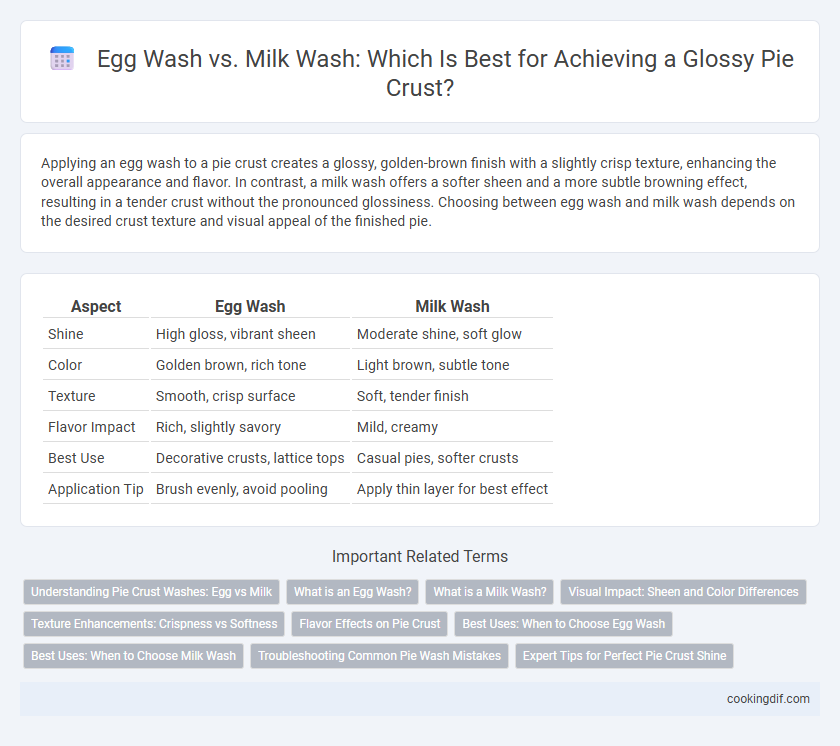Applying an egg wash to a pie crust creates a glossy, golden-brown finish with a slightly crisp texture, enhancing the overall appearance and flavor. In contrast, a milk wash offers a softer sheen and a more subtle browning effect, resulting in a tender crust without the pronounced glossiness. Choosing between egg wash and milk wash depends on the desired crust texture and visual appeal of the finished pie.
Table of Comparison
| Aspect | Egg Wash | Milk Wash |
|---|---|---|
| Shine | High gloss, vibrant sheen | Moderate shine, soft glow |
| Color | Golden brown, rich tone | Light brown, subtle tone |
| Texture | Smooth, crisp surface | Soft, tender finish |
| Flavor Impact | Rich, slightly savory | Mild, creamy |
| Best Use | Decorative crusts, lattice tops | Casual pies, softer crusts |
| Application Tip | Brush evenly, avoid pooling | Apply thin layer for best effect |
Understanding Pie Crust Washes: Egg vs Milk
Egg wash, composed of beaten eggs with or without water or milk, creates a rich, glossy, and deep golden sheen on pie crusts, enhancing both appearance and texture. Milk wash, primarily using whole or skim milk, imparts a softer, matte finish with a mild browning effect, ideal for a subtler crust coloration. Choosing between egg and milk wash depends on the desired crust finish and flavor intensity, with egg wash offering a shinier and more robust crust compared to the gentler, creamier look from a milk wash.
What is an Egg Wash?
An egg wash is a mixture of beaten eggs, sometimes combined with water or milk, applied to pie crusts before baking to create a glossy, golden-brown finish. This wash enhances the crust's color and texture, providing a visually appealing sheen that sets it apart from the more subtle dullness achieved with milk wash. Egg washes contain proteins that coagulate and promote browning, resulting in a more vibrant and appetizing pie crust.
What is a Milk Wash?
Milk wash for pie crust is a simple mixture applied before baking to enhance the crust's golden-brown color and subtle sheen. Typically made from whole milk or cream, milk wash adds a slightly sweet glaze that doesn't overpower the crust's natural flavor. Unlike egg wash, milk wash creates a softer, less glossy finish, making it ideal for tender, flaky pie crusts.
Visual Impact: Sheen and Color Differences
Egg wash enhances pie crust sheen by creating a rich, golden-brown color with a glossy finish due to its protein and fat content, which promote browning through the Maillard reaction. Milk wash results in a softer, matte sheen and a lighter, more subtle golden hue because of its lactose and water composition. Choosing egg wash intensifies visual appeal with a vibrant, shiny crust, while milk wash offers a gentle coloration for a more understated look.
Texture Enhancements: Crispness vs Softness
Egg wash creates a glossy, golden finish on pie crusts while enhancing crispness due to its protein content, which promotes browning and adds a slightly firm texture. Milk wash results in a softer, matte sheen by adding moisture and subtle sweetness without increasing crust crispness, making it ideal for tender, delicate pastries. Choosing egg wash intensifies crust crunch, whereas milk wash preserves pliability and prevents excessive hardness.
Flavor Effects on Pie Crust
Egg wash enhances pie crust sheen with a rich, golden-brown finish and imparts a subtle savory flavor that complements both sweet and savory fillings. Milk wash creates a softer crust with a mild, slightly sweet taste and less pronounced gloss, making it ideal for delicate dessert pies. Choosing egg wash or milk wash influences not only the crust's appearance but also contributes distinct flavor profiles to the overall pie experience.
Best Uses: When to Choose Egg Wash
Egg wash is ideal for pie crusts requiring a rich, golden-brown sheen and a slightly glossy finish, making it perfect for fruit pies and savory pastries. Its protein content enhances browning during baking, providing a visually appealing, crisp texture compared to milk wash. Use egg wash when aiming for an eye-catching crust that stands out in presentation and texture.
Best Uses: When to Choose Milk Wash
Milk wash provides a subtle, soft golden sheen that enhances pie crusts without overpowering delicate flavors, making it ideal for sweet pies like apple, cherry, or pumpkin. It helps achieve a tender, slightly glossy finish, perfect for recipes where a gentle crust appearance complements the fruit filling. Milk wash also adds a slight browning effect suitable for pies requiring a lighter crust color with a smooth texture.
Troubleshooting Common Pie Wash Mistakes
Egg wash creates a glossy, golden finish on pie crusts, but using too much can cause burning or a rubbery texture, while too little results in a dull appearance. Milk wash offers a softer sheen and a tender crust but can produce a paler color if applied excessively or unevenly. Avoid applying washes too thickly or on a warm crust to prevent streaks and uneven browning.
Expert Tips for Perfect Pie Crust Shine
For a perfectly shiny pie crust, expert bakers recommend using egg wash, which creates a rich, golden-brown sheen due to its protein and fat content. Milk wash offers a softer, matte finish with a lighter color, making it ideal for a subtler crust appearance. Applying egg wash just before baking ensures an even, glossy surface, while brushing milk wash allows for a more tender, delicate crust texture.
Egg wash vs milk wash for pie crust sheen Infographic

 cookingdif.com
cookingdif.com